Contents:
Hektoen Enteric Agar : Principle | Preparation | Interpretation
Ⅰ. Overview
It is medium for the isolation of Shigella and Salmonella, it was originally developed by King and Metzger (1968) of the Hektoen Institute. It is based on the use of bile salts for selective inhibition and two indicator systems (pH indicator system):
- Bromothymol blue and acid fuchsin as indicators of carbohydrate dissimilation (lactose, sucrose, salicin)
- Ferric iron as an indicator of the formation of hydrogen sulphide (H2S) from thiosulfate.
Hektoen Enteric (HE) Agar is a moderately selective differential medium used for the isolation and culture of gram-negative enteric microorganisms, particularly for the isolation of Shigella and Salmonella species from fecal (mixed flora) samples.
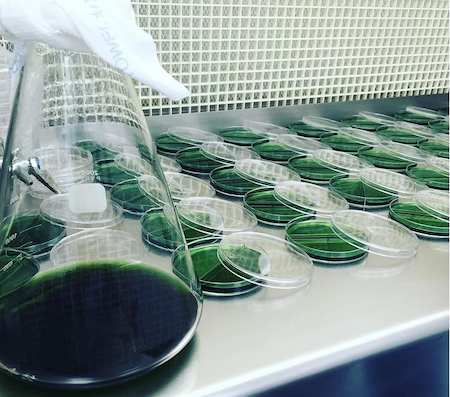
Hektoen Enteric (HE) Agar (@gueroviagero)
Ⅱ. Preparation / Composition
Suspend the components, dried powder, in water (72.66 grams in 1000 ml purified/distilled water). The medium is boiled for a few seconds until the ingredients are completely dissolved. Do not autoclave or overheat .
Cool to 47°C and pour into Petri dishes. Final pH should be 7.5 + 0.2.
Hektoen Enteric agar composition |
|||
|---|---|---|---|
| Ingredients | gram/litre | Ingredients | gram/litre |
| Protease peptone | 12g | Yeast extract | 3g |
| Sodium chloride | 5g | bile salt | 9g |
| Ammoniacal iron citrate | 1,5g | Salicin | 2g |
| Lactose | 12g | Saccharose | 12g |
| Fuchsin acid | 0,1g | Bromothymol blue | 0,065g |
| Agar | 14g | final pH | 7,5 ± 0,2 |
◈ Hoben and al added 15 mg / liter of novobiocin to improve the selectivity of the medium by inhibiting the Citrobacter and Proteus species.
Ⅲ. Principle of Hektoen Agar
Hektoen Enteric agar is a selective and differential medium for the isolation and differentiation of pathogens from clinical samples.
◈ Selectivity : The presence of bile salts and dyes inhibits most Gram-positive organisms, which only allows Gram-negative bacilli to develop on agar.
The high concentration of bile salts partially or totally inhibits most of the non-pathogenic coliform flora of the intestinal tract. Because Salmonella and Shigella can tolerate these inhibitory substances, they generally develop faster and larger than coliforms.
◈ Differentiation : The fermentation of carbohydrates such as lactose, sucrose and salicin is one of the differentiating characteristics used to identify coliforms. Bromothymol blue turns yellow in the presence of acid and fuchsin turns red in the presence of aldehyde.
Salmonella and Shigella are unable to use these three specific carbohydrates (translucent colonies, light green or greenish blue ), while most non-pathogenic coliforms can use at least one (orange, yellow or salmon coloured colonies ).
Additional differentiation based on hydrogen sulphide production is possible due to the presence of sodium thiosulphate and iron citrate. It results in black colonies or black center, staining due to the formation of iron sulphide .
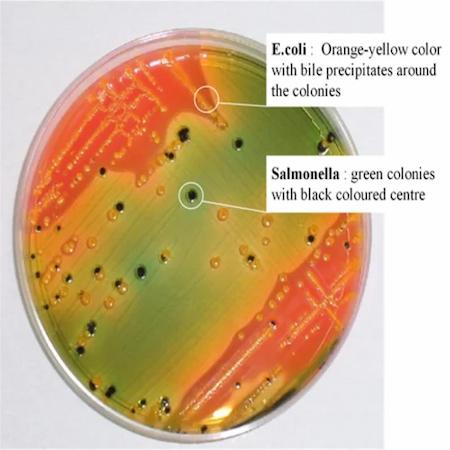
Salmonella and E.coli on Hektoen Enteric agar
Note :
- Bile salts can precipitate out of the medium and appear as a cloudy area around colonies.
- High peptone content compensates for the inhibitory effect of bile salts on Shigella species in particular
Ⅳ.Interpretation
◈ After 24 hours at 37°C aerobically, generally:
- Fermentation of at least one of the sugars results in a "salmon / yellow / orange" coloration of the colonies.
- The absence of fermentation results in a blue or green coloration of the colonies.
- The production of hydrogen sulfide (H2S) is characterized by black or black center colonies.
| species | Growth |
|---|---|
| E. coli | Large size, yellow to salmon colour, possible inhibition of some strains |
| Enterobacter/Klebsiella | Large size, yellow to salmon |
| Proteus | Variable size, from blue-green to blue or salmon, most strains being black in the centre or on their entire surface |
| Salmonella | Blue-green to blue in colour, most strains being black in the centre or over their entire surface. All Salmonella serotypes have this aspect on HE agar with the exception of the Typhi serotype, which is a low producer of H2S, and rare lactose-fermenting strains of Salmonella. |
| Shigella | Green color, moist and convex |
| Pseudomonas | Irregular, green to brown in color |
| Gram-positive bacteria | No / low growth |
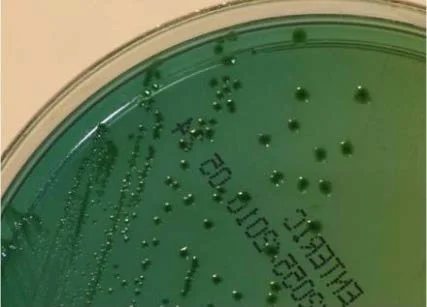
Shigella. Colonies are transparent, indicating no use of carbohydrates and no production of H2S (@CERTEST)
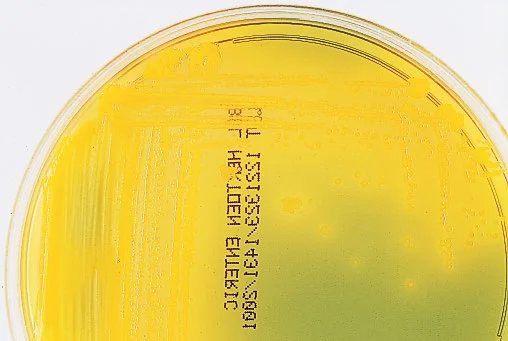
Aeromonas hydrophila grows well on Hektoen agar, producing yellow colonies because it ferments sucrose (9).
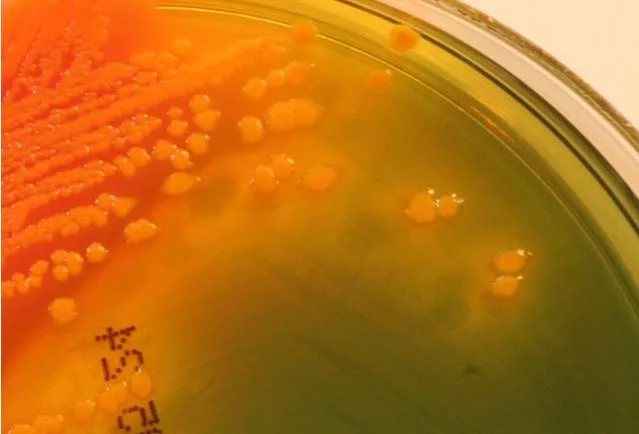
Strain fermenting salicin of Proteus vulgaris (50% of strains are positive). There is no precipitation of bile salts by this organism (2).
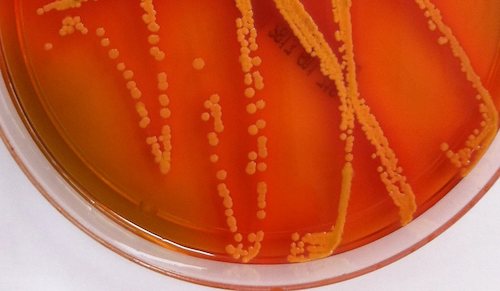
E.coli on Hektoen Enteric Agar
References:
- Corry JEL, et al. Handbook of Culture Media for Food Microbiology. Hektoen Enteric (HE) Agar. [Lieu de publication]: [Éditeur]; 2003.
- American Society for Microbiology. Hektoen Enteric Agar Protocol [Internet]. [cité 12 février 2025]. Disponible sur: https://asm.org/.
- Versalovic J, et al. Color Atlas of Medical Bacteriology. 3rd ed. [Lieu de publication]: [Éditeur]; [année inconnue]. Disponible sur: https://www.wiley.com/en-us/Color+Atlas+of+Medical+Bacteriology%2C+3rd+Edition-p-9781683670353.
- BD Diagnostics. BD Hektoen Enteric Agar (HE Agar) [Internet]. [cité 12 février 2025]. Disponible sur: [URL à compléter].
- American Society for Microbiology. ASM MicrobeLibrary [Internet]. [cité 12 février 2025]. Disponible sur: [URL à compléter].
- Oxoid. Oxoid™ Hektoen Enteric Agar [Internet]. [cité 12 février 2025]. Disponible sur: [URL à compléter].
- Austin Community College District. [Informations sur Hektoen Enteric Agar] [Internet]. [cité 12 février 2025]. Disponible sur: [URL à compléter].
- Hoben H. Some observations on the incorporation of novobiocin into Hektoen Enteric Agar for improved Salmonella isolation [Internet]. [cité 12 février 2025]. Disponible sur: https://www.ncbi.nlm.nih.gov/pmc/articles/PMC379732/.